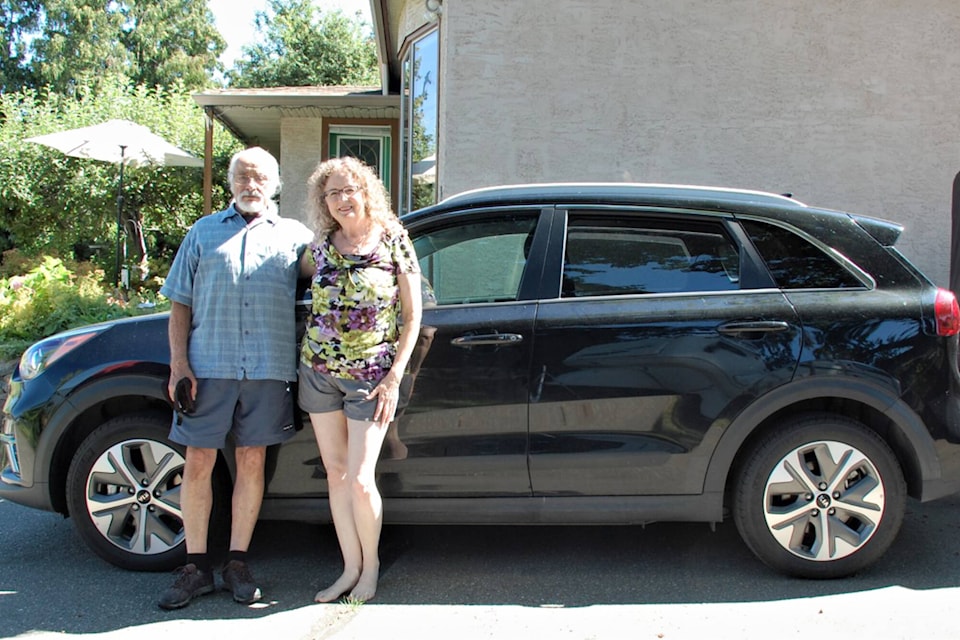A Salmon Arm couple’s cross-Canada journey by electric vehicle had their EV perform flawlessly, but revealed room for improvement as far as Highway 1 charging stations go.
Over the summer, Juanita Austin and spouse Jim McConnell decided to challenge themselves, and their 2020 electricity-powered Kia Niro, with a road trip to the Maritimes and back. They wanted to make the journey while they still have enough energy and enthusiasm to “go the distance,” Austin explains.
And, in recognizing gasoline-fueled vehicles are a major contributor to greenhouse gas emissions, they wanted to use the trip to “encourage as many people as possible to make the switch to electric vehicles,” she adds.
“If we could drive across the country on electricity alone, maybe others would be willing to overcome their range anxiety and do it too.”
Packing as light as possible, Austin and McConnell set out on July 28. Their plan was to follow the Trans-Canada Highway, for the most part, from Salmon Arm to Nova Scotia.
“We had a few detours,” Austin says. “The first took us to Delburne, Alta. for a family reunion, and then we joined up with the Trans-Canada to Maple Creek, Sask. We side-tripped to Rosetown, Sask., and then back down to Regina and followed the Trans-Canada to Kenora, Ont.
“A fortuitous conversation with another EV driver had us do a major detour, down south to Sioux Narrows and over to Fort Frances, and then east toward Thunder Bay. The detour was because the few EV stations on the Trans-Canada were not reliable, and we did not want to have to be towed. This person had just faced a $500 tow bill.”
Austin says they got as far as Blind River, east of Sault Ste. Marie, when they realized they’d contracted COVID. They were eventually able to isolate in an empty manse offered for their use in Kazabazua, Que.
“We weren’t scheduled to be there for another five days, but could we arrive early? Our hosts said yes, and we arrived at 9:30 p.m. to a house with the cupboards and fridge full of food, beds made and fresh towels,” Austin says. “We waited out our isolation in the 100-year-old manse, and were so well taken care of by our hosts and other community members.”
From there the couple continued eastward, through Quebec and into New Brunswick.
“We meandered our way to Halifax, and then headed for the Cabot Trail in Cape Breton. From there we took the ferry to PEI for a quick tour and visit.”
The journey home followed, with Austin and McConnell arriving back in Salmon Arm on Sept. 23.
While their vehicle performed flawlessly, the couple did run into issues with charging stations. At one service station they were told after they began charging their vehicle that the charger wasn’t functional.
“It would charge for about five minutes and then just stop,” Austin says. “Oh, and the guy who looked after all their charging stations in western Canada was in San Francisco.”
A friend told the couple about , a website where they could find level 2 and 3 charging stations along the route, and read comments by other EV users, including information about which chargers were putting out a decent amount of power, and which were simply not working.
Another challenge was a need for different apps to use the different charging stations they stopped at along the way.
“For two computer Luddites it was a very stressful learning curve,” Austin says.
Regardless, Austin and McConnell were driven to complete their journey.
“We are tenacious. From time to time we had to remind ourselves that trials were an acceptable part of the adventure, and that we had come too far to give up… We tried to be philosophical – realizing that infrastructure always seems to follow the new invention, not lead it. We were pioneers, doing this to encourage others, we told ourselves. And we never had to get towed – either by horse or tow truck.”
The trip took 58 days – more than 200 driving hours. In that time, Austin and McConnell added 14,059 kilometres to their odometer – and five EV station apps to their phone. With zero GHG emissions, the couple estimated it cost $700 ($5 per 100 kilometres) to drive the 14,000 kms.
Having made the journey, Austin and McConnell have some recommendations for the powers that be to make the transition to electric vehicles more feasible. One is to get the infrastructure standardized across the country so it’s more user-friendly.
“Make it simple – so you really can just use a credit card or debit card as you go,” Austin says, noting some charging stations want you to pre-purchase a certain amount of power. “That might be fine if you live in the province and will be using the stations repeatedly, but not if you are just passing through – leaving you with unused credit.”
The couple also recommends better signage indicating where charging stations are located.
“We need much better and quicker repair services when a station is down,” Austin says. “There are definitely job opportunities in this sector that should be encouraged and supported by all levels of government.”
Regarding government, the couple suggest there at least be a partial rebate available for the – not just rebates for new vehicles.
Overall the trip was a success, providing an opportunity for Austin and McConnell to see the country and connect in person with family, friends and “many kind strangers who were helpful along the way.”
If you’re interested in new or used vehicles, be sure to visit to find your dream car today! Like us on and follow us on



